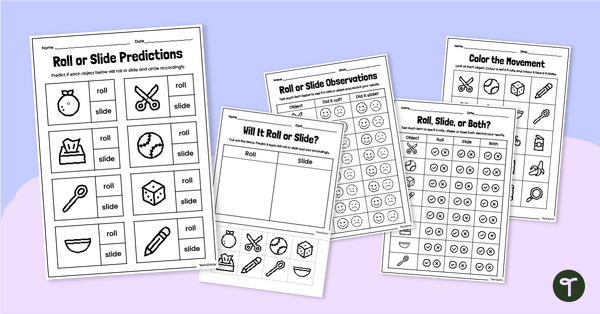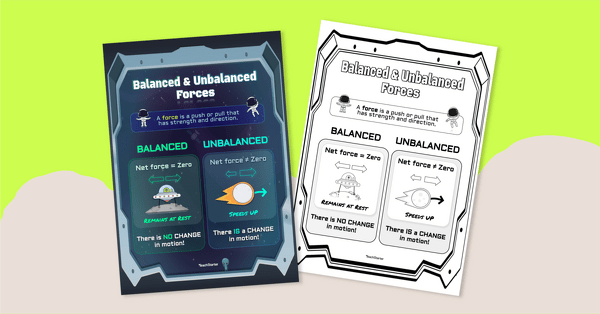Motion Teaching Resources
Explore the science of motion with printable and digital activities, worksheets and more — created for science teachers by teachers like you!
Aligned with both TEKS and the NGSS curriculum, this collection of resources covers everything you need to plan lessons on the different aspects of motion from the speed of an object to the way force affects its movement.
Looking to better understand this part of the science curriculum? Or maybe you just need some handy definitions on hand for introducing your unit on motion? Read on for a primer from our teacher team, including meanings for some key words for teaching about this physical science concept.
What Is Motion? A Kid-Friendly Definition
We'll kick things off with a simple definition of motion that you can use to introduce your lesson to your students:
Motion is the movement of objects or changes in their position over time. Motion is occurring all around us all the time, from the wind blowing to cars rolling by. Even the Earth is in motion, very slowly rotating on its axis beneath our feet.
Teaching About Motion — Key Vocabulary Words
Along with the meaning of motion itself, there are a number of key vocabulary words that tie into how we observe and measure motion. Keep these definitions handy to help describe them to your students!
Distance Definition
When we measure motion, one key word we use is distance. Distance is how far an object has moved from its starting point.
For example, if a student is standing beside her desk and walks to the door of the classroom, the space between the desk and the door could be measured to determine the distance of her movements or motion.
Speed Definition
Another important word to define when studying motion is speed. Speed is how fast an object moves when it is in motion.
For example, when you are in a car that drives from your home to school, it will travel at a certain speed. That speed helps determine how quickly the car moves from one place to the other.

We measure speed in units per hour such as miles per hour.
Direction Definition
The direction of motion is also key to understanding this physical science concept. Direction is which way an object is moving.
We use words like east or west, up or down and forward or backward to describe direction.
What Are Activities That Show Motion?
We already touched on the motion of the wind and cars, but some more examples of activities that show motion are always useful! Here are some everyday activities that many of our students engage in that show motion:
- Walking
- Jumping
- Climbing
- Riding a bicycle
- Skateboarding
- Kicking a soccer ball
- Throwing a baseball
- Plus Plan

Roll or Slide Worksheets - Science Inquiry (K-1)
Explore motion and boost science inquiry skills with Roll or Slide Worksheets.
- Plus Plan

Isaac Newton's Laws of Motion - Anchor Charts
Learn about Isaac Newton and his 3 Laws of Motion with a set of printable anchor charts.
- Plus Plan

Moving Materials Science Experiment Pack
Explore materials and how they behave with an engaging Moving Materials Science experiment pack.
- Plus Plan

Roll & Measure Science Investigation (K-2)
Explore movement and measurement with informal units with an engaging Roll and Measure Science Experiment for K-2 students.
- Plus Plan

Ways Things Move - Science Sorting Activity
Introduce your K-1 students to the world of motion and scientific categorization with a printable ‘How Things Move’ Sorting Activity.
- Plus Plan

Flashcards - Pictures of Simple Machines
36 illustrated pictures of simple machines to display in the classroom when learning about simple machines.
- Plus Plan

Make a Dinosaur Long-Arm Activity
A fun activity to use in the classroom when learning about simple machines and how they work.
- Plus Plan

Using Simple Machines - Worksheet
Download a set of simple machines worksheets to use in the classroom when learning about simple machines and how they can help use solve everyday problems.
- Plus Plan

Simple Machines Posters
5 illustrated posters to display in the classroom when learning about simple machines.
- Plus Plan

Simple Machines - 3 Classes of Levers Posters
An illustrated poster to use in the classroom when learning about different types of levers.
- Plus Plan

Drawing Simple Machines
A worksheet to use in the classroom when learning about simple machines and what they look like.
- Plus Plan

Simple Machines Sorting Activity
A fun sorting activity to use in the classroom when learning about simple machines and how they work.
- Plus Plan

Simple Machines Definition Worksheets
6 definition worksheets to use in the classroom when learning about simple machines and their uses.
- Plus Plan

Simple Machines Roller Coaster Challenge - STEM Project
Implement a Roller Coaster Stem Project to help your students demonstrate knowledge of simple machines.
- Plus Plan

Balanced and Unbalanced Forces Teaching Slides
Teach your students about balanced and unbalanced forces with this comprehensive and age-appropriate teaching presentation for 6th grade science lessons.
- Plus Plan

Balanced and Unbalanced Forces Task Cards
Use these force and motion task cards as a student review activity in your 6th grade science lessons.
- Plus Plan

Balanced and Unbalanced Forces Quiz
Assess students' understanding of balanced and unbalanced forces with this force and motion quiz for 6rd grade students.
- Plus Plan

Balanced and Unbalanced Forces Cut-and-Paste Worksheets
Explore examples of balanced and unbalanced forces with your students using this set of two cut-and-paste worksheets.
- Free Plan

Balanced and Unbalanced Forces Anchor Chart
Use this force and motion anchor chart when teaching your students about balanced and unbalanced forces.
- Plus Plan

Balanced and Unbalanced Forces Minibook
Teach your students about balanced and unbalanced forces with this printable mini-book perfect for 6th grade science lessons.
- Free Plan

Simple Machines Word Wall
Use this set of 28 printable vocabulary word wall cards to enhance your students vocabulary surrounding force, motion, and simple machines.
- Plus Plan

Force and Motion – Poster Pack
Display information about force and motion with this set of 12 vocabulary posters.
- Plus Plan

Force and Motion Task Cards
Use these force and motion task cards as a student review activity in your 3rd grade science lessons.
- Plus Plan

Force and Motion Vocabulary Posters
Display this set of 22 mini-posters in your classroom when learning about force and motion vocabulary.